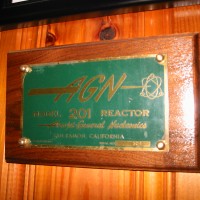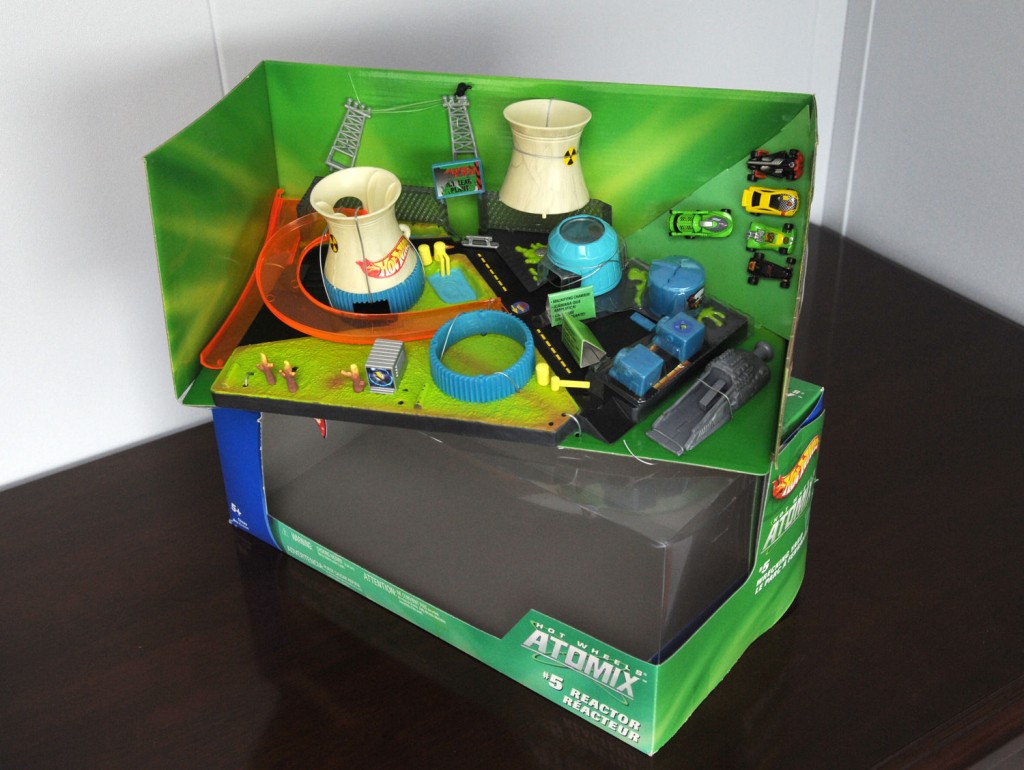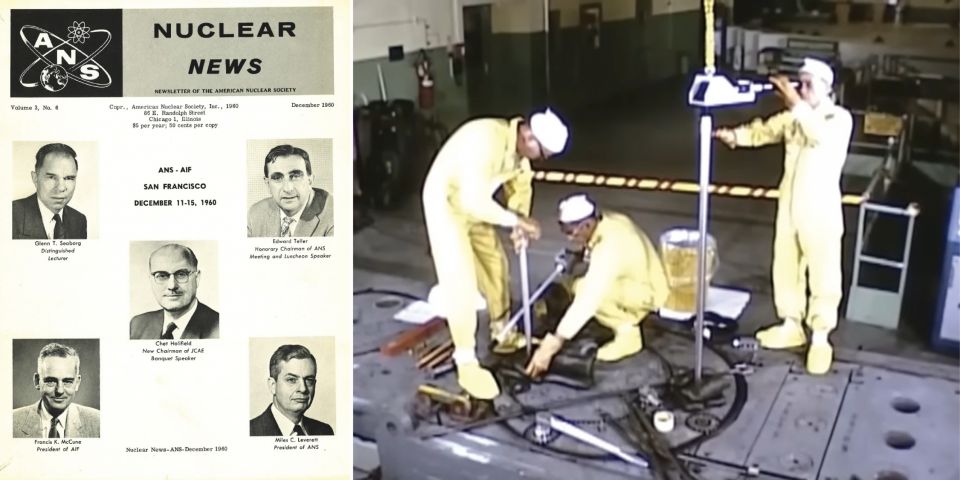Nuclear Artifacts
Editor: Will Davis
As I have traveled to various places, spoken to numerous people involved with nuclear science and nuclear energy, and made friendships, I've become aware that the majority of us involved in the field have accumulated very special objects and papers that mean something to us, are the point of a humorous anecdote, or have real historical impact. Since every once in a while we do a "crowd sourced" blog post here on ANS Nuclear Cafe, I thought it would be both educational and probably fun to see what I'd get if I put out a request to my colleagues for some stories about such nuclear artifacts. Below are the responses I've received from the colleagues, followed by my own submission. As you will see, I was not disappointed.
***
Robert Margolis
In the summer of 1976, I was 11 years old and on the way back to San Diego from a Disneyland trip. My dad remembered that the San Onofre plant (Units 2 and 3 were then under construction) had a visitor center and he wanted to stop off and see it. While the center was educational and interesting, it was the last piece that made the difference. I was handed a card with a plastic pellet giving the energy equivalent of uranium versus fossil fuels. Living in California, I could not relate to coal or fuel oil, but my eyes grew wide as saucers upon reading that the pellet if real would be worth 157 gallons of gasoline. The mental image of my dad's old white Volvo speeding along from San Diego to New York City powered by that small pellet was stuck in my head. Of course, pellets cannot power cars, but the image inspired a great respect for nuclear energy that has never left me. I still have that card from San Onofre as a memento of the moment I learned there was a technology that rivaled science fiction.
***
Leslie Corrice
The most prized artifact from my Naval nuclear experience is a piece of paper. When I was discharged, I was given a small letter-sized folder. The discharging officer told me to open it. Inside was a Presidential Letter of Appreciation signed by Richard Nixon. I was flummoxed because I had done nothing I considered noteworthy. The officer said everyone on my crew was getting one with their discharge papers. When I asked why, he just shrugged. All I can figure out is that my ship had been converted from Polaris to Poseidon missiles, and we were the first submarine, so converted, to go operational. However, the main reason I prize the letter so much is a bit vicarious. I was never a fan of Nixon, to say the least. He resigned the day I was discharged. Every time I look at the letter hanging on my wall, a wicked little sneer forms on my mouth.***
My most cherished piece of nuclear junk is the name-plate off an AGN model 201 reactor. It's hung on the wall in my office. See the photo to the right.When I was in grad school at Georgia Tech I got a reactor operator license to operate it, all 100 milliwatts. It was one of three reactors on campus at that time, the 1970s. It was the most approachable reactor with student experiments, and it was definitely the safest. One student built a pile oscillator that fit neatly in the glory hole. I used it for rod-drop control calibration experiments with it wired to a classic PDP-8 minicomputer. It was serial number 104. I think AGN probably started with serial number 101. Georgia Tech bought it from a university in Dayton, Ohio.
As the nuclear engineering school collapsed and was incorporated into the mechanical engineering school in the late 1980s, the old AGN was decommissioned. It was sad to see it go. The bio-shield tank wound up in the fenced yard in back of the Georgia Tech Research Reactor (a 5MW CP-5 replica) and I asked a health physicist to retrieve one of two name-plates for me. He was glad to see someone interested in it. It was even more painful to watch as they tore down the big reactor a few years ago. There will never be another one, and students now do their experiments using computer simulations. It's just not the same.
(AGN-201 plate photo courtesy Jim Mahaffey. AGN-201 exterior view as designed ca. 1956 and cross section view from Aerojet-General sales material, incl. reproductions from 'Nucleonics,' 1956, Will Davis collection.) Click photos to enlarge.
***
Margaret Harding
Can an artifact be a color? My "artifact" is Cherenkov radiation. I simply love the blue/indigo color and every time I see that color I usually react and smile.Stories that relate:
I went to a major General Electric management training class at the corporate center in Crotonville, NY, in 2002. As a part of that class, it was a tradition that each participant have a small "give-away" for the rest of the class. Mine was a pen with a blue LED in it that glowed an almost perfect Cherenkov glow. The gift was given right before each participant gave a small talk on their business. In my case I had carefully removed the battery protection so that the pens could be easily turned on. Playing the pens as I talked, I thanked the participants for taking a small bit of nuclear waste-and then explained the glow. You could hear the pens clatter to desks all across the room.
Second story: My poor son, every time I saw that color I would make a comment. As he got older he also got the technical explanation for its existence. When he visited North Carolina State University and got a reactor tour as a high school senior, the tour guide asked the students if any of them knew what color the nuclear glow was. Since the advent of the Simpsons TV show, almost universally the answer has been "green". Until my son, he said, almost automatically, "Cherenkov blue". The guide was astounded and quizzed him to find out why he knew that. He was thoroughly embarrassed to have to explain his mother's obsession with the color.
Finally, during the wild days of my media work covering Fukushima, I created a drink I called the Cherenkov Glow: Equal parts vodka and Blue Curacao with a brazil nut as a garnish. Why? Vodka for Cherenkov's Russian background. Blue Curacao to get the correct color. Brazil nut because it is one of the most radioactive foods on the planet (loaded with selenium). It made some of the more stressful moments a bit easier.
***
Brian Dyke
One of my favorite activities since high school has been visiting thrift stores with friends. It's a great place to find old electronics, records, and ridiculous clothing. Growing up between Plant Vogtle and the Savannah River Site meant I'd find the occasional discarded nuclear souvenir, usually old shirts and hats to commemorate plant outages. My favorite find is an H.B. Robinson '84 outage hat. It isn't particularly pretty; it's just a trucker hat with the CP&L and old-style Westinghouse logos and a Bohr model situated over the silhouette of a containment dome.It's special to me because I accepted a job at that particular plant the very next year. I wore that hat on one of my first days and got some pretty memorable reactions from some of the older guys. It really helped to break the ice and make me less nervous about starting my new job. Sure, it's nothing tremendously cool like a piece of graphite from CP-1, but I've got an entire career ahead of me to collect cool nuclear trinkets.
***
Uli Decher
Here is a real geeky artifact. It is a cardboard slide rule that computes the Feed and Separative Work for enriching UF6. I used that frequently when I worked at Nuclear Materials and Equipment Corp. back in the late '60s. I worked on some interesting reactor concepts for terrestrial and space applications. They were mostly paper studies that never got off the ground. The company is now decommissioned and this may be one of the few artifacts left.
***
David Petti
This Hot Wheels toy is part of a 5 piece set that envisions the modern city. It has been part of the Next Generation Nuclear Plant Project (NGNP) since its inception. What I like about it is that it shows nuclear power as a key part of the modern city. It does take some artistic license with the car track running through the cooling tower! I would enjoy meeting the team at Mattel that worked on this toy to get their views on nuclear power. But in the end, as the R&D director for NGNP, when I ask myself what type of reactor could be sited close to a population center I think about a modular HTGR, passively safe with a very low reactor source term.
***
I think that all of the above submissions are fantastic-and I might have to try to find one of those Hot Wheels sets to tuck away for when my nephew, presently two years old, is able to appreciate it. Now, we'll finish up with my favorite item.
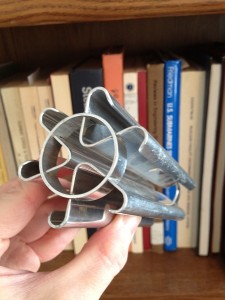 The object at left that you see held in my hand is a dummy fuel element duplicate to those provided by Sylvania-Corning Nuclear Corporation for use in the Brookhaven Research Reactor. The element is shorter in overall length, but duplicates the original elements in other details such as thickness of plates, the radii of bends, and the end rings. It simply does not have any uranium in it. This demonstration piece came to me as part of a large collection of nuclear energy related material that I purchased from an estate some time back; eventually, buried in all of that material I did find a receipt for this particular demonstration piece. It represents many things to me-not the least of which is the remembrance of the early nuclear energy era when so much time, effort, innovation, and money were being put into the field; the design itself was something Syl-Cor cooked up to provide major operational improvements to the Brookhaven reactor that improved its usefulness several fold. It holds a prominent place on my bookshelf at all times as a reminder to keep forging ahead, to keep innovating, to look for new horizons and goals.
The object at left that you see held in my hand is a dummy fuel element duplicate to those provided by Sylvania-Corning Nuclear Corporation for use in the Brookhaven Research Reactor. The element is shorter in overall length, but duplicates the original elements in other details such as thickness of plates, the radii of bends, and the end rings. It simply does not have any uranium in it. This demonstration piece came to me as part of a large collection of nuclear energy related material that I purchased from an estate some time back; eventually, buried in all of that material I did find a receipt for this particular demonstration piece. It represents many things to me-not the least of which is the remembrance of the early nuclear energy era when so much time, effort, innovation, and money were being put into the field; the design itself was something Syl-Cor cooked up to provide major operational improvements to the Brookhaven reactor that improved its usefulness several fold. It holds a prominent place on my bookshelf at all times as a reminder to keep forging ahead, to keep innovating, to look for new horizons and goals.
I hope that others who see this post are encouraged to find such items as they may still have, and once there are enough submissions we'll do another one of these "Nuclear Artifacts" blog posts. You can contact me at: atomicpower AT willdavis DOT org with submissions and ideas. I myself have a number of other things to show, and I'm betting many of my friends and ANS members will line up with other objects and tales of times gone by.
_____________________________
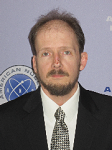 Will Davis is a consultant to, and writer for, the American Nuclear Society. In addition to this, Davis is on the Board of Directors of PopAtomic Studios, is a contributing author for Fuel Cycle Week, and also writes his own blog Atomic Power Review. Davis is a former US Navy Reactor Operator, qualified on S8G and S5W plants.
Will Davis is a consultant to, and writer for, the American Nuclear Society. In addition to this, Davis is on the Board of Directors of PopAtomic Studios, is a contributing author for Fuel Cycle Week, and also writes his own blog Atomic Power Review. Davis is a former US Navy Reactor Operator, qualified on S8G and S5W plants.


